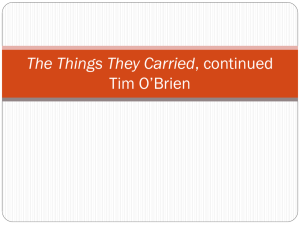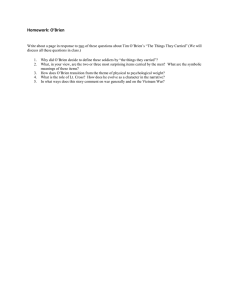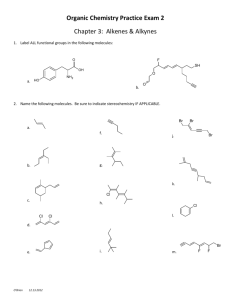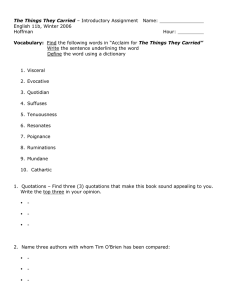act26.doc
advertisement
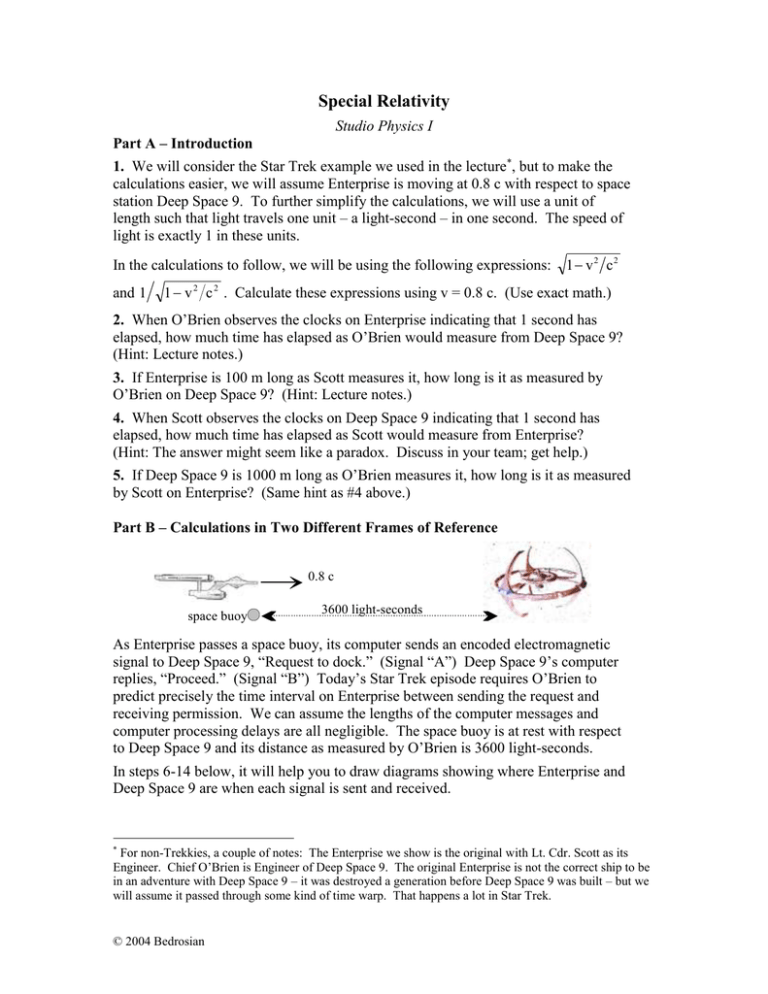
Special Relativity Studio Physics I Part A – Introduction 1. We will consider the Star Trek example we used in the lecture*, but to make the calculations easier, we will assume Enterprise is moving at 0.8 c with respect to space station Deep Space 9. To further simplify the calculations, we will use a unit of length such that light travels one unit – a light-second – in one second. The speed of light is exactly 1 in these units. In the calculations to follow, we will be using the following expressions: 1 v 2 c 2 and 1 1 v 2 c 2 . Calculate these expressions using v = 0.8 c. (Use exact math.) 2. When O’Brien observes the clocks on Enterprise indicating that 1 second has elapsed, how much time has elapsed as O’Brien would measure from Deep Space 9? (Hint: Lecture notes.) 3. If Enterprise is 100 m long as Scott measures it, how long is it as measured by O’Brien on Deep Space 9? (Hint: Lecture notes.) 4. When Scott observes the clocks on Deep Space 9 indicating that 1 second has elapsed, how much time has elapsed as Scott would measure from Enterprise? (Hint: The answer might seem like a paradox. Discuss in your team; get help.) 5. If Deep Space 9 is 1000 m long as O’Brien measures it, how long is it as measured by Scott on Enterprise? (Same hint as #4 above.) Part B – Calculations in Two Different Frames of Reference 0.8 c space buoy 3600 light-seconds As Enterprise passes a space buoy, its computer sends an encoded electromagnetic signal to Deep Space 9, “Request to dock.” (Signal “A”) Deep Space 9’s computer replies, “Proceed.” (Signal “B”) Today’s Star Trek episode requires O’Brien to predict precisely the time interval on Enterprise between sending the request and receiving permission. We can assume the lengths of the computer messages and computer processing delays are all negligible. The space buoy is at rest with respect to Deep Space 9 and its distance as measured by O’Brien is 3600 light-seconds. In steps 6-14 below, it will help you to draw diagrams showing where Enterprise and Deep Space 9 are when each signal is sent and received. * For non-Trekkies, a couple of notes: The Enterprise we show is the original with Lt. Cdr. Scott as its Engineer. Chief O’Brien is Engineer of Deep Space 9. The original Enterprise is not the correct ship to be in an adventure with Deep Space 9 – it was destroyed a generation before Deep Space 9 was built – but we will assume it passed through some kind of time warp. That happens a lot in Star Trek. © 2004 Bedrosian 6. We start by calculating the elapsed time in the frame of reference of O’Brien. How long does Signal A take to reach Deep Space 9? (Hint: Easy to calculate.) 7. Where is Enterprise when Signal A is received by Deep Space 9? 8. How long does Signal B take to reach Enterprise? (Hint: Enterprise is moving toward Deep Space 9 while the signal is moving toward Enterprise.) 9. What is the total time for Signal A followed by Signal B as measured by O’Brien? 10. What total time does O’Brien predict for Scott measured on Enterprise? 11. Now we shift our frame of reference to Scott on Enterprise. First, we need to decide how far he determines he is from Deep Space 9 when he sends Signal A. Is it 3600 light-seconds or some other distance? (Hint: In this frame of reference, what are the speeds of Enterprise, the space buoy, and Deep Space 9?) 12. How long does Signal A take to reach Deep Space 9? (Hint: Deep Space 9 is moving toward Enterprise while the signal is moving toward Deep Space 9.) 13. Where is Deep Space 9 when Signal A is received by Deep Space 9? 14. How long does Signal B take to reach Enterprise? 15. What is the total time as measured by Scott? Does this agree with 10 above? If not, check your work and ask your TA or instructor for help if necessary. If you did the calculations correctly, you will note that Scott measures Signal A reaching Deep Space 9 20 minutes after sending it, exactly halfway through the total time interval. On the other hand, O’Brien measures that Signal A reaches Deep Space 9 well after halfway through the total time interval he would predict for Scott’s clocks. We are talking about two events at different locations in space: one is the arrival of Signal A at Deep Space 9 and the other is Scott’s clock reaching 20 min. When two events at different locations are simultaneous in one inertial frame of reference, they will not be simultaneous in an inertial frame of reference with a component of motion in the direction of displacement between the two events! Part C – Science Fact / Science Fiction Except for the idea of a ship-sized object reaching 0.8 c, everything in this activity is based on science fact, not science fiction. It is within the capabilities of current technology to send computer signals over distances of 3600 light-seconds or more. In fact, in communicating with the Voyager space probes, we have done exactly that. However, providing enough energy to get a ship moving 0.8 c with respect to Earth is a daunting task for today’s technology. We will do some quick calculations. 16. The fully-loaded mass of U.S. Battleship New Jersey is approximately 55. x 106 kg. At full speed, it moves at 17 m/s. What is its kinetic energy? (Use ½ m v2.) 17. Assume Enterprise has the same mass as BB New Jersey. What is its kinetic energy at 0.8 c? (Use the relativistic formula from the notes.) What is the ratio of KE of Enterprise to KE of BB New Jersey? (Hint: A really big number!) 18. If the world’s total electrical power generating capacity is 3.3 x 1012 J/s, how many years would it take to generate enough kinetic energy for Enterprise? © 2004 Bedrosian
